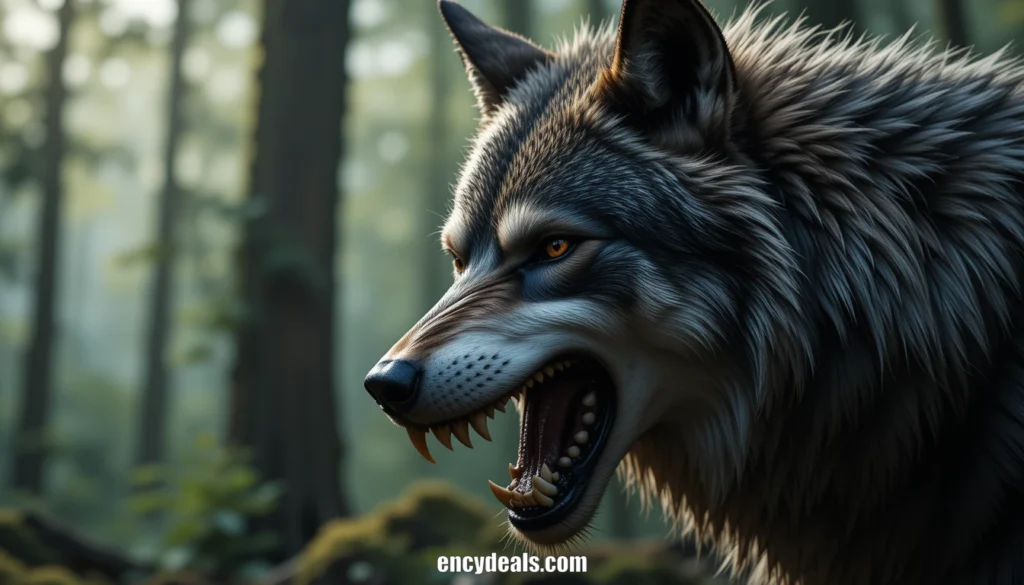Dire Wolf: 10 Shocking Facts About This Legendary Beast

The dire wolf (Canis dirus) is one of the most legendary prehistoric predators ever to walk the Earth. Often mistaken as a fictional creature due to its frequent appearance in pop culture, the dire wolf was very real and once roamed across North and South America.
Larger and more robust than today’s gray wolves, dire wolves have intrigued paleontologists for decades. This article explores their physical traits, diet, habitat, extinction, and much more, based on scientific research and fossil discoveries.

Physical Characteristics and Appearance
The dire wolf was larger, heavier, and more muscular than the modern gray wolf, With an estimated weight between 130–150 pounds, dire wolves had powerful jaws and strong teeth, perfectly adapted to crush bones and hunt large prey.
Key Physical Traits:
- Height: Around 38 inches at the shoulder
- Weight: 130–150 pounds on average
- Skull & Teeth: Broader skull with strong premolars for bone crushing
- Build: Stockier limbs, suited for strength rather than speed
This wolf had a fearsome appearance, giving it a dominant role in its ecosystem.
Habitat and Geographic Range
Dire wolves once thrived across a vast range in North and South America, particularly during the Late Pleistocene Epoch (approximately 250,000 to 10,000 years ago). Fossils have been discovered from Canada to Bolivia, indicating their adaptability to different environments.
Preferred Habitats:
- Grasslands and open woodlands
- Ice Age valleys and plains
- Areas rich in large herbivore prey
They coexisted with mammoths, saber-toothed cats, and giant ground sloths.
Diet and Hunting Behavior
As apex predators, dire wolves relied heavily on large herbivorous mammals. Their strong teeth and jaws helped them take down prey such as bison, horses, camels, and even young mammoths.
Hunting Strategies:
- Hunted in cooperative packs, much like modern wolves
- Used ambush and endurance to overpower prey
- Ate carrion when live prey was scarce
Their robust physique made them less agile but ideal for pack-based hunting, ensuring successful kills.
Fossil Discoveries and Research
Dire wolf fossils are among the most common large mammal fossils found in the La Brea Tar Pits in Los Angeles, California, which has yielded over 4,000 individual dire wolves.
Major Fossil Sites:
- La Brea Tar Pits (USA)
- Cutler Hammock Fossil Site (Florida)
- Talara Tar Seeps (Peru)
These fossils help scientists understand their evolution, social behavior, and ecological impact.

Extinction: Causes and Timeline
The dire wolf went extinct around 10,000 years ago, coinciding with the end of the last Ice Age. Several theories attempt to explain their disappearance:
Likely Causes:
- Climate Change: Shrinking grasslands led to fewer large herbivores
- Human Activity: Early humans may have hunted dire wolves’ prey
- Competition: Outcompeted by smaller, more adaptable predators like gray wolves and coyotes
Their specialization for large prey may have limited their adaptability, leading to extinction.
Differences Between Dire Wolves and Gray Wolves
Though similar in appearance, dire wolves and gray wolves are not direct ancestors or the same species. DNA analysis reveals that dire wolves belonged to a different genus and diverged millions of years ago.
Key Differences:
| Feature | Dire Wolf | Gray Wolf |
| Size | Larger and heavier | Leaner and more agile |
| Build | Stocky and muscular | Slim and fast |
| Diet | Large herbivores | More varied diet |
| Genus | Aenocyon dirus | Canis lupus |
This distinction has reshaped how scientists view canine evolution.
Cultural and Pop Culture Significance
The dire wolf achieved iconic status in modern pop culture, especially through HBO’s Game of Thrones, where it symbolizes strength, loyalty, and mystery.
Appearances in Pop Culture:
- Game of Thrones – House Stark’s symbol and pet companions
- Video Games – Featured in games like ARK and Assassin’s Creed
- Books & Comics – Often used as fantasy creatures
This has helped renew public interest in the real-life dire wolf, driving educational content and scientific outreach.
Recent Scientific Developments
In 2021, a breakthrough DNA study revealed that dire wolves were genetically distinct from all other modern wolves, separating them by 5+ million years.
New Discoveries:
- Part of the genus Aenocyon, not Canis
- Not closely related to gray wolves despite similarities
- Evolved in isolation in the Americas
These findings challenge long-held beliefs and highlight the importance of DNA analysis in paleontology.
Conclusion
The dire wolf remains one of the most fascinating extinct predators of the Ice Age. From its massive size and hunting prowess to its mysterious extinction and cultural rebirth, it continues to capture imaginations and fuel scientific research.
Key Takeaways:
- Real, prehistoric apex predator
- Larger and more powerful than modern wolves
- Played a vital role in Ice Age ecosystems
- Went extinct ~10,000 years ago
- A star in science and pop culture
Whether you’re a fan of prehistoric animals or a pop culture enthusiast, the dire wolf offers a compelling glimpse into the ancient world.
FAQs
1. Were dire wolves real animals?
Yes, dire wolves were real and lived during the Late Pleistocene Epoch. They are now extinct but were once among the top predators in North and South America.
2. How big was a dire wolf compared to a gray wolf?
Dire wolves were larger and more muscular than modern gray wolves. They weighed around 130–150 pounds, while gray wolves typically weigh 70–110 pounds.
3. What did dire wolves eat?
Dire wolves were carnivores and mainly hunted large Ice Age mammals like bison, horses, camels, and mammoths. They also scavenged when necessary.
4. When did dire wolves go extinct?
Dire wolves went extinct approximately 10,000 years ago, likely due to climate change, habitat loss, and competition from other predators.
5. Are dire wolves ancestors of modern wolves?
No. Despite physical similarities, DNA research shows that dire wolves and modern wolves are not closely related. They evolved separately for millions of years.
6. Where have dire wolf fossils been found?
Fossils have been found throughout North and South America, especially at sites like the La Brea Tar Pits in California, which has thousands of dire wolf specimens.
7. Are dire wolves related to the wolves in Game of Thrones?
The dire wolves in Game of Thrones are fictional versions based on the real animal. The show’s wolves are larger and more mystical, but the name is inspired by the actual dire wolf.
8. What is the scientific name of the dire wolf?
The dire wolf was previously classified under Canis dirus, but recent studies suggest the correct classification is Aenocyon dirus, meaning “terrible wolf.”
9. Could dire wolves be brought back through cloning or de-extinction?
Currently, no viable DNA samples exist that would allow for cloning. While the idea is explored in science fiction, bringing back dire wolves is not yet possible with today’s technology.
10. What makes dire wolves different from other Ice Age predators?
Dire wolves were social pack hunters, unlike solitary predators like saber-toothed cats. Their pack behavior and strong jaw structure set them apart in Ice Age ecosystems.







